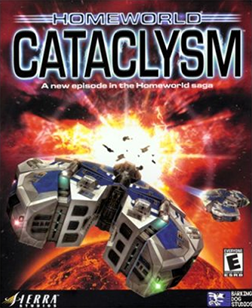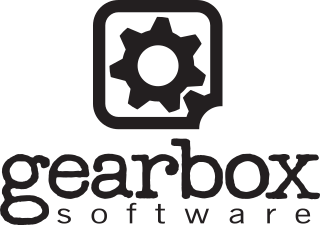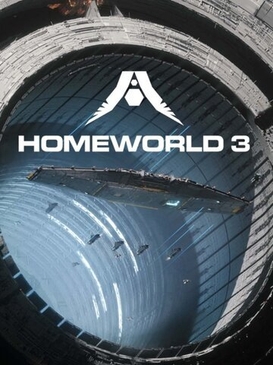
THQ Inc. was an American video game company based in Agoura Hills, California. It was founded in April 1990 by Jack Friedman, originally in Calabasas, and became a public company the following year through a reverse merger takeover. Initially working in the toy business, it expanded into the video game business through several acquisitions before shifting its focus away from toys entirely. THQ continued its trend of acquiring companies throughout the 2000s.

Homeworld: Cataclysm was originally developed in 2000 as an expansion of Homeworld, but was released as a stand-alone game. It was published by Sierra Studios, as was the original, but it was developed by Barking Dog Studios.
Relic Entertainment Inc. is a Canadian video game developer based in Vancouver, founded in 1997. The studio specializes in real-time strategy games and is known for series such as Homeworld, Warhammer 40,000: Dawn of War and Company of Heroes. Acquired by THQ in 2004, the company was sold to Sega on January 22, 2013 as part of THQ's bankruptcy and operated under its European division. On March 28, 2024, Sega sold the company to an unnamed external investor.

Gearbox Software is an American video game development company based in Frisco, Texas. It was established as a limited liability company in February 1999 by five developers formerly of Rebel Boat Rocker. Randy Pitchford, one of the founders, serves as president and chief executive officer. Gearbox initially created expansions for the Valve game Half-Life, then ported that game and others to console platforms. In 2005, Gearbox launched its first independent set of games, Brothers in Arms, on console and mobile devices. It became their flagship franchise and spun off a comic book series, television documentary, books, and action figures. Their second original game series, Borderlands, commenced in 2009, and by 2015 had sold over 26 million copies. The company also owns the intellectual property of Duke Nukem and Homeworld.
The concept brainship in science fiction literature refers to an interstellar starship that is created by inserting the disembodied brain and nervous system of a human being into a life-support system, and connecting it surgically to a series of computers via delicate synaptic connections. The brain "feels" the ship as part of its own body. Flying, taking off, landing, and controlling all the other features of the ship are as natural as moving, breathing and talking are to an ordinary human. Being wired into a computer speeds their reactions, but still allows their human brains to make intelligent decisions based on calculations.

Deep Silver Volition, LLC was an American video game developer based in Champaign, Illinois. Mike Kulas and Matt Toschlog founded the company as Parallax Software in June 1993, developing Descent and Descent II. By the time the sequel was completed, Toschlog had relocated to Ann Arbor, Michigan, with some employees to operate a satellite studio for Parallax. Kulas and Toschlog decided to split up the company, with Toschlog establishing Outrage Entertainment and Kulas staying with Parallax, which was renamed Volition in November 1996. With publisher Interplay Entertainment, Volition created Descent: FreeSpace – The Great War and its sequel, FreeSpace 2. The two companies parted ways during the development of Summoner.

Homeworld is a real-time strategy video game developed by Relic Entertainment and published by Sierra Studios on September 28, 1999, for Windows. Set in space, the science fiction game follows the Kushan exiles of the planet Kharak after their home planet is destroyed by the Taiidan Empire in retaliation for developing hyperspace jump technology. The survivors journey with their spacecraft-constructing mothership to reclaim their ancient homeworld of Hiigara from the Taiidan, encountering a variety of pirates, mercenaries, traders, and rebels along the way. In each of the game's levels, the player gathers resources, builds a fleet, and uses it to destroy enemy ships and accomplish mission objectives. The player's fleet carries over between levels and can travel in a fully three-dimensional space within each level rather than being limited to a two-dimensional plane.

Genesis Rising: The Universal Crusade is a 3D Real-time strategy game set in a distant future. The game was developed by Metamorf, published by DreamCatcher Interactive and released in 2007. The game takes place in space, where players control ships and try to eliminate the opponent. The game's primary focus is on squad tactics. The story is set in a mysterious futuristic universe where organic machines are built using genetic engineering. The player take on the role of Captain Iconah to explore and conquer the Universal Heart, the only part of the universe that's remained unconquered by the forces of humankind. Many of the ships are made of organic rather than synthetic material.

Destroy All Humans! is an open world action-adventure video game franchise that is designed as a parody of Cold War-era alien invasion films. Destroy All Humans! and Destroy All Humans! 2 were released for the PlayStation 2 and Xbox; Destroy All Humans! Big Willy Unleashed was released for the Wii; and Destroy All Humans! Path of the Furon was released for the Xbox 360 and PlayStation 3. A remake of the original game and its sequel were developed by Black Forest Games and were released in 2020 and 2022, respectively.
Project Eagle is an interactive art demo of a colony on Mars, developed by Blackbird Interactive in collaboration with NASA's Jet Propulsion Laboratory. It was released on Steam on 27 November 2018, in honor of the successful InSight landing.

Warhammer 40,000: Dawn of War II – Retribution is the stand-alone second expansion to Warhammer 40,000: Dawn of War II, part of the Warhammer 40,000: Dawn of War series of real-time strategy video games. Set in Games Workshop's Warhammer 40,000 fictional universe, the single player campaign is playable with multiple races.

Darksiders II is an action role-playing hack and slash video game developed by Vigil Games and published by THQ. It is the sequel to Darksiders and was released in August 2012 for Microsoft Windows, PlayStation 3, Xbox 360 and as a launch title for Wii U upon the console's North American and PAL regions release in November of the same year. The story follows the efforts of player character Death to clear the name of his brother, War, who stands accused of wiping out humanity. On a total budget of $50 million, it was one of the most expensive video games to develop of all time.

Homeworld: Deserts of Kharak is a real-time strategy video game developed by Blackbird Interactive and published by Gearbox Software. The game was released on January 20, 2016, and is a prequel to the 1999 space-based real-time strategy video game Homeworld.

Blackbird Interactive is a Canadian video game development studio based in Vancouver, British Columbia.
Embracer Group AB is a Swedish video game and media holding company based in Karlstad. The company comprises 11 operative groups: Amplifier Game Invest, Asmodee, CDE Entertainment, Coffee Stain, Dark Horse Media, Deca Games, Easybrain, Freemode, Gearbox Entertainment, Plaion, and THQ Nordic.

Homeworld 3 is a real-time strategy video game being developed by Blackbird Interactive and published by Gearbox Software. The game was released on May 13, 2024.

Warhammer Age of Sigmar: Storm Ground is a turn-based strategy game developed by Gasket Games and published by Focus Home Interactive in collaboration with Games Workshop. Based on the Warhammer: Age of Sigmar miniature wargame, the game released for Windows, Nintendo Switch, PlayStation 4 and Xbox One on May 27, 2021.
Homeworld is a series of real-time strategy video games created by Relic Entertainment. Relic Entertainment developed the first two Homeworld games. The series then spent over a decade in dormancy until Gearbox Software acquired the franchise in 2012 and tasked Blackbird Interactive to develop Homeworld 3, the third mainline installment of the franchise, and the spin-off game Homeworld: Deserts of Kharak.

Homeworld: Vast Reaches is a virtual reality real-time strategy game developed by FarBridge and published by Gearbox Software. It was released on the Meta Quest 2 and Meta Quest 3, with plans to release it as a PC VR title later in 2024. It is a part of the Homeworld series of games.














